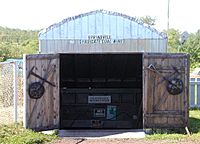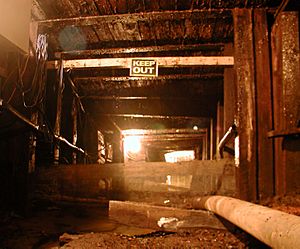Springhill Coal Mining National Historic Site facts for kids
Quick facts for kids Springhill Coal Mining |
|
|---|---|
| Nova Scotia Coal Fields | |

An entrance to a Springhill mining shaft
|
|
| Location | Springhill, Nova Scotia, Canada |
| Built | 1873 |
| Current use | Museum |
| Governing body | Parks Canada |
| Official name: Springhill Coal Mining National Historic Site of Canada | |
| Designated | 12 March 1998 |
The Springhill Coal Mining site is a National Historic Site of Canada. It is located in Springhill, Nova Scotia. This special site was recognized in 1998. It includes a museum and the land where the famous Springhill Coal Mines once stood.
Springhill was once one of the most important places for coal mining in Canada. Other big coal areas were in Pictou and Cape Breton. Coal from Springhill was sent and sold all over the Maritimes and Quebec. The old mining features you can still see in Springhill are some of the most complete in Canada. The Springhill Mines became well-known because of several terrible disasters. These included explosions in 1891 and 1956, and a "bump" (an underground earthquake) in 1958.
Contents
A Look Back: Springhill's Mining Story
Springhill played a huge part in Nova Scotia's coal mining boom. This busy time lasted from the 1870s to the 1940s. Coal from Springhill, Pictou, and Cape Breton was sold across Eastern Canada. The money earned from this coal helped Nova Scotia become more industrial. This means it grew more factories and businesses.
Local mining grew a lot when the Intercolonial Railway expanded in the early 1900s. This led to the creation of the Cumberland Coal Company. Mining was very hard and dangerous work. Miners needed special skills to work deep underground. The mines were often at risk of explosions and underground earthquakes.
Dangerous Times: The Mining Disasters
There were several major disasters at the Springhill mines. In 1891 and 1956, coal dust explosions caused many deaths. In 1958, an underground earthquake, called a "bump," made parts of the mine collapse. These events show how risky coal mining could be.
Why Springhill is a Historic Site
The Springhill site is important because of its role in Canada's history. It helped Nova Scotia and Canada become more industrial after Confederation (when Canada became a country). Nova Scotia was Canada's biggest coal producer from 1867 until 1914. This was partly because of taxes on foreign coal. Also, there was a high demand for coal in other provinces in the late 1800s.
After the two big disasters in the 1950s, mining slowed down. The mine officially closed in 1970. Today, you can still see some brick buildings from the original mine. There are also sealed entrances to the old No. 2 and No. 4 mines. The entrance to the Syndicate Mine is still open for the museum. Springhill was named a National Historic Site of Canada on March 12, 1998. Other coal mining sites in Stellarton and Sydney, Nova Scotia were also recognized.
Visiting the Museum
The National Historic Site has a main building. It is a one-story red brick building that used to be a lamp cabin for the miners. The museum helps us remember the sad events at the mine. It also celebrates the bravery of the miners during those disasters. It tells the story of how coal mining brought good times to Springhill.
The museum offers tours of the wash house and the lamp cabin. You can also take a tour of a part of the underground mine that is still open.


